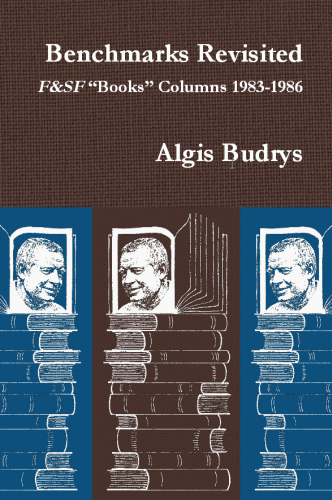




Ansible Editions/Lulu.com, 2013
ISBN 978-1-291-43604-4
6" x 9" trade paperback, 267 pages
Ebook ISBN 978-1-913451-01-1
The cover illustration – showing Budrys in the 1980s – is based on the F&SF “Books” column masthead drawn by Tom Bevans, then art director for Simon & Schuster. This masthead appeared from January 1985 to August 1987.
Edited by David Langford and Greg Pickersgill.
Benchmarks Revisited: F&SF “Books” Columns 1983-1986 is the second instalment of a three-volume collected edition of all Algis Budrys’s classic SF review columns for The Magazine of Fantasy and Science Fiction. Published: 1 July 2013. Ebook edition February 2014. Approximately 159,000 words with index.
“When we attempt to measure space and time, we must use numbers with many zeroes in them. Zeroes are read as nullity, and many of our writers seem unaware that an attempt to make the journey to Andromeda seem vast by packing it with zero-equivalents will result, instead, in a sense that the thing is about the size of a basketball and floating off just beyond Hoboken.”
Algis Budrys, May 1985 column
“As well as one of the best writers in our field, Algis Budrys was the best writer about our field. These essays are much more than reviews – altogether they’re a deeply perceptive history of science fiction literature.”
Tim Powers, 2013
“There have been three fathers of sf criticism, Damon Knight, James Blish, and A J Budrys. More than any of their heirs, they knew sf inside out, from the 1940s onward. They all wrote well, and more than well. AJ also wrote vastly: authoritative, loose, sharp, casual, tough; and with all the past at his command. He told us everything he could. This 460,000 word trilogy is only a part of that gift. Feast well. We shall see nothing of its like ever again.”
John Clute, 2013
“The ‘Books’ columns themselves are not just books columns but performances, full of fireworks, digressions, wise insights, witty asides, penetrating mini-essays on writing and publishing, entertaining personal crotchets, and even footnotes. They repay close reading.”
David Langford, 2013 (from the introduction)